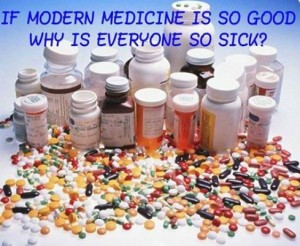Humans have always ingested substances they believe to bring health. E.g. many foods are believed to heal, such as prunes for constipation, honey and lemon for colds, garlic as an antiseptic, and so on. Then there are herbs, valued for their efficacious effects everywhere. In some cultures, they even eat soil for its healing properties.
What do all these substances have in common? They all change the body’s chemistry, and we know how powerful changes in our biochemistry can be. Even procedures that appear as mechanical as an organ transplant have biochemical components, hence the need for transplant recipients to take anti-rejection drugs.
Is illness primarily a change in our biochemistry? Is there nothing more to healing than of finding where the body’s chemistry is out of kilter and correcting it? That’s what many people believe.

Healing substances traditionally came from nature
Take herbs for example – they can be taken in their natural state, or made into tinctures and tablets, or smoked. Water’s healing properties have also long been recognised, and dietary therapy is a major plank of traditional Chinese medicine. The Greek physician Hippocrates advised two thousand years ago to let our food be our medicine and our medicine be our food.
However, we now take our healing doses in stronger form. Originally most drugs were simply highly concentrated forms of plant and other natural essences, but nowadays most drugs are developed from chemical concoctions in laboratories. Biochemists try to isolate the active chemical ingredients in substances known to have healing properties and turn them into pills, powders and liquids etc. So pervasive is this approach that drugs have become synonymous with mainstream medicine. And they do work – to some degree, at least!
How drugs are developed
But few people realise how new drugs are ‘invented’. Mostly it’s a trial and error process, and some, like Viagra, are discovered by accident. Viagra was intended as a treatment for angina, but researchers noticed a strange side effect (!!). Marketing people quickly realised they had a profitable product on their hands. It’s not unusual for manufacturers to discover what a drug will do only when they trial it, and side effects may not come to notice until the drug is launched onto the market.
The truth is, there is no such thing as a totally safe drug. By their very nature they are designed to alter a biological process. The question is – what risks are we willing to take in our pursuit of a ‘cure’?
Shortcomings of drugs
If the Hippocratic Oath – to do no harm – were taken seriously, many pharmaceutical medicines would never be prescribed, because they are unpredictable and often highly toxic. Most doctors are aware of their shortcomings. One told me that the only difference between most drugs and poisons is the dose!
Sometimes the authorities are reluctant to take a product off the market even after it has been suspected of being dangerous. For example, a drug claimed to relieve diabetes, Avandia, was still on the market three years after it was shown to kill 19% of those who took it![1]
Shortcomings include:
- Cost. Most of the world’s population can’t afford them; some countries, like Hungary and Cuba, fund research into alternatives simply because they don’t want to be held hostage by the multinational drug companies.
- Tolerance – with any drug, you build up tolerance. The more you take, the more you need to get the same effect/‘benefits’.
- Side effects. Read the information leaflet that comes with any prescribed drug, and you will find a long (and sometime shocking) list of its possible side effects. For example, Seroxat (Paroxetine) has been blamed for causing chronic hepatitis, seizures, suicidal tendencies and abnormal bleeding and is also believed to raise the suicide rate by a factor of eight!!!
- Modern medicine assumes that we all function the same, hence individual differences are not taken into account. No-one knows for sure what a drug will do to an individual until they take it.
- Addiction. There is no difference in effect between addiction to street drugs like heroin and addiction to, say, painkillers, the only difference is that the latter are easily available.
- Suppressing short-term symptoms using drugs can cause long-term illness.
- Drugs also distort diagnoses. When a new drug is announced to address a particular condition, suddenly more people seek treatment claiming to have that condition.
Antidepressants
Over 80% of prescriptions for anti-depressants are for SSRI’s – Serotonin Selective Reuptake Inhibitors, the best known of which are Paroxetine and Fluoxetine (Prozac).
They are based on a theory first proposed in 1967, that people become depressed because they are low in serotonin, a neurotransmitter which acts on the peripheral and central nervous system. However, this theory has never been proved. One expert, Dr Jeffrey Lacasse from Florida State University[2], states ‘There is not a single peer-reviewed article that can be accurately cited to support claims of serotonin deficiency in any mental disorder.’
Until the 1990s, research (mostly financed by the pharmaceutical companies) showed that antidepressants helped about three quarters of people with depression, which reinforced the belief that they were safe and effective. But then a seminal study in 1998[3] showed that, yes, they lift depression in most patients, but are no more than effective than placebos.
There are alternatives. Psychotherapy works well for moderate and severe depression, and a combination of psychotherapy and a short course of antidepressants works even better. But except in cases of very severe chronic depression, the largest part of the drugs’ effect comes from the fact that patients expect to be helped by them, and not from any direct chemical action on the brain.
The debate continues, and sadly in the public consciousness, the pharmaceutical companies with their huge advertising and public relations budgets are probably winning.

Preventative drugs
It is in the drug companies’ interests to make us dependent on them, which is why a new generation of drugs don’t just treat the problems we have, but are marketed as preventatives for illnesses we may have one day. Statins, for example, reduce cholesterol in the blood, thus – it is claimed – reducing the risk of heart attacks, angina and strokes. These claims are based on the premise that high cholesterol is a major factor in heart attacks – yet 75% of heart attack victims have been shown to have normal levels of cholesterol!
The pharmaceutical companies recommend that statins be given to people with ‘normal’ levels of cholesterol as a preventative – hence ‘normal’ is now perceived as ‘risky.’ They want us all to take drugs as preventatives, not just those who are ill. The public increasingly accept this, believing they can have a longer, healthier life the easy way.
It seems the pharmaceutical industry has us under mass hypnosis. It dominates the medical journals and reigns unchallenged in medical schools. It spends a fortune on sales promotion and successfully challenges any approach to healing that does not serve its interests (including most forms of natural medicine).
Do drugs have their place?
Despite all this, drugs do have their place. They can bring quick relief; sometimes they are essential because they are all we have, such as anti-rejection drugs which can bring transplant patients a reasonable quality of life, and drugs for mental health conditions such as bi-polar disorder and schizophrenia which enable sufferers to live a relatively normal life.
I believe that one day most pharmaceuticals will be as redundant as leeches are today. As a society we are still to tap the full potential of the mind’s capacity to heal or take energy and informational medicine seriously. The new AcuPearl range, for instance, has shown remarkable effects for pain relief, insomnia, anxiety and depression. Can you imagine Dr Crusher using pharmaceuticals on the Starship Enterprise? I think not!
©David Lawrence Preston, 8.5.2016

Follow me on Facebook and Twitter @feelinggoodatt
See also http://www.feelinggoodallthetime.com/new-approaches/
[1] Source: What Doctors Don’t Tell You, e-bulletin, 2nd March 2010, www.wddty.com
[2] Co author of the essay, ‘Serotonin and Depression: A Disconnect Between the Advertisements and the Scientific Literature,’ PLoS Med, 2005; 12: 1211-6
[3] Whose findings were reinforced by landmark research in The Journal of the American Medical Association conducted by Irving Kirsch and Guy Sapirstein of the University of Connecticut.




